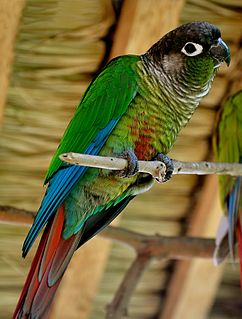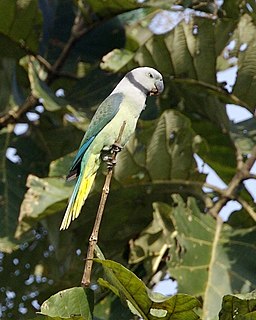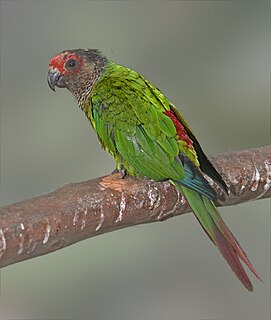
The Alexandrine parakeet, also known as the Alexandrine parrot, is a medium-sized parrot in the genus Psittacula of the family Psittaculidae. It is named after Alexander the Great, who transported numerous birds from Punjab to various European and Mediterranean countries and regions, where they were prized by the royalty, nobility and warlords.

The green-cheeked parakeet or green-cheeked conure is a small parrot of the genus Pyrrhura, which is part of a long-tailed group of the New World parrot subfamily Arinae. The term conure is often used for this parrot and its relatives in aviculture. It is native to the forests of South America.

The orange-bellied parrot is a small parrot endemic to southern Australia, and one of only three species of parrot that migrate. It was described by John Latham in 1790. A small parrot around 20 cm (8 in) long, it exhibits sexual dimorphism. The adult male is distinguished by its bright grass-green upper parts, yellow underparts and orange belly patch. The adult female and juvenile are duller green in colour. All birds have a prominent two-toned blue frontal band and blue outer wing feathers.

The slaty-headed parakeet is the only psittacid species to exhibit altitudinal migration. The species' range extends from Pakistan, to Western Himalayas in India through Nepal and Bhutan and up to the Eastern Himalayas in the northeastern Indian state of Arunachal Pradesh. They descend to the valleys in winter, approximately during the last week of October.

The blue-winged parakeet, also known as the Malabar parakeet is a species of parakeet endemic to the Western Ghats of southern India. Found in small flocks, they fly rapidly in forest clearings while making screeching calls that differ from those of other parakeet species within their distribution range. Their long blue tails tipped in yellow and the dark wings with blue contrast with the dull grey of their head and body. Adult males and females can be easily told apart from the colour of their beak.

Lord Derby's parakeet, also known as Derbyan parakeet, is a parrot species, which is confined to a small pocket of moist evergreen forest in the hills and mountains of the Indian states of Arunachal Pradesh and Assam, and adjoining parts of Tibet, Sichuan and Yunnan in China. The species suffers from cutting of old trees and poaching for the illegal wildlife trade. In 2011, its status was updated from least concern to near threatened on the IUCN Red List. The adult male and female are easily distinguished because they have different beak colours and slightly different plumage.

The white woodpecker is a South American species of woodpecker native to the wooded grasslands of Suriname, French Guiana, Brazil, Bolivia, Paraguay, Uruguay and Argentina. It is a bright white bird with black wings and a distinctive small bright yellow eye patch. The IUCN has rated it as a "least-concern species".

The orange-fronted parakeet or orange-fronted conure, also known as the half-moon conure, is a medium-sized parrot that is resident from western Mexico to Costa Rica.

The nanday parakeet, also known as the black-hooded parakeet or nanday conure, is a medium-small, mostly green, Neotropical parrot native to continental South America.

The dusky-headed parakeet, also known as Weddell's conure or dusky-headed conure in aviculture, is a small green Neotropical parrot with dusty grey head found in wooded habitats in the western Amazon basin of South America. Its range extends from southeastern Colombia south through eastern Ecuador, eastern Peru and southwest Amazonian Brazil, to central Bolivia. It prefers semiopen habitats such as várzea, forest edge, and forest remnants, but can also be found in coffee plantations. It is generally common and its habitat preference makes it less vulnerable than many other Amazonian species. Consequently, it is considered to be of least concern by BirdLife International and IUCN.

The maroon-bellied parakeet is a small parrot found from southeastern Brazil to north-eastern Argentina, including eastern Paraguay and Uruguay. It is also known as the reddish-bellied parakeet, and in aviculture it is usually referred to as the maroon-bellied conure, reddish-bellied conure or brown-eared conure.

The olivaceous siskin is a species of finch in the family Fringillidae. It is found in Bolivia, Ecuador, and Peru, where its natural habitats are subtropical or tropical moist montane forests and heavily degraded former forest.

The rufous-fronted parakeet is a species of parrot in the family Psittacidae. Endemic to Colombia, its natural habitats are high-altitude shrubland, high-altitude grassland and arable land. It is threatened by habitat destruction and is classified as "vulnerable" by the International Union for Conservation of Nature.

The mountain parakeet, also known as the golden-fronted parakeet, is a species of parrot, one of two in the genus Psilopsiagon within the family Psittacidae. It is found in the Puna grassland. Its natural habitat is subtropical or tropical high-altitude shrubland. Four subspecies are recognised.

The thick-billed ground pigeon, also known as the jungle pigeon or the slaty/grey ground pigeon, is a species of bird in the family Columbidae. It is monotypic within the genus Trugon. Native to New Guinea, its natural habitat is moist tropical lowland forest.

The ochre-breasted tanager is a species of bird in the family Cardinalidae. It is found in Colombia and Ecuador where its natural habitats are subtropical or tropical moist lowland forests and subtropical or tropical moist montane forests. As a fairly common species with a stable population, the International Union for Conservation of Nature has rated this bird as being of "least concern".

The rose-fronted parakeet, also known as the red-crowned parakeet, or, in aviculture, the rose-fronted conure, is a species of parrot in the family Psittacidae. It is found in the western Amazon basin in eastern Peru, far south-eastern Ecuador, north-western Bolivia and far western Brazil. It includes the wavy-breasted parakeet, also known as the wavy-breasted conure, which sometimes is considered a separate species.

The sun parakeet, also known in aviculture as the sun conure, is a medium-sized, vibrantly colored parrot native to northeastern South America. The adult male and female are similar in appearance, with predominantly golden-yellow plumage and orange-flushed underparts and face. Sun parakeets are very social birds, typically living in flocks. They form monogamous pairs for reproduction, and nest in palm cavities in the tropics. Sun parakeets mainly feed on fruits, flowers, berries, blossoms, seeds, nuts, and insects. Conures are commonly bred and kept in aviculture and may live up to 30 years. This species is currently threatened by loss of habitat and trapping for plumage or the pet trade. Sun parakeets are now listed as endangered by the IUCN.

The northern mealy amazon or northern mealy parrot is among the largest parrots in the genus Amazona, the amazon parrots. It is a mainly green parrot with a total length of 38–41 cm (15–16 in). It is endemic to tropical Central America. This species and the southern mealy amazon were previously considered conspecific. Some taxonomic authorities (including the American Ornithological Society, continue to lump them together.





















